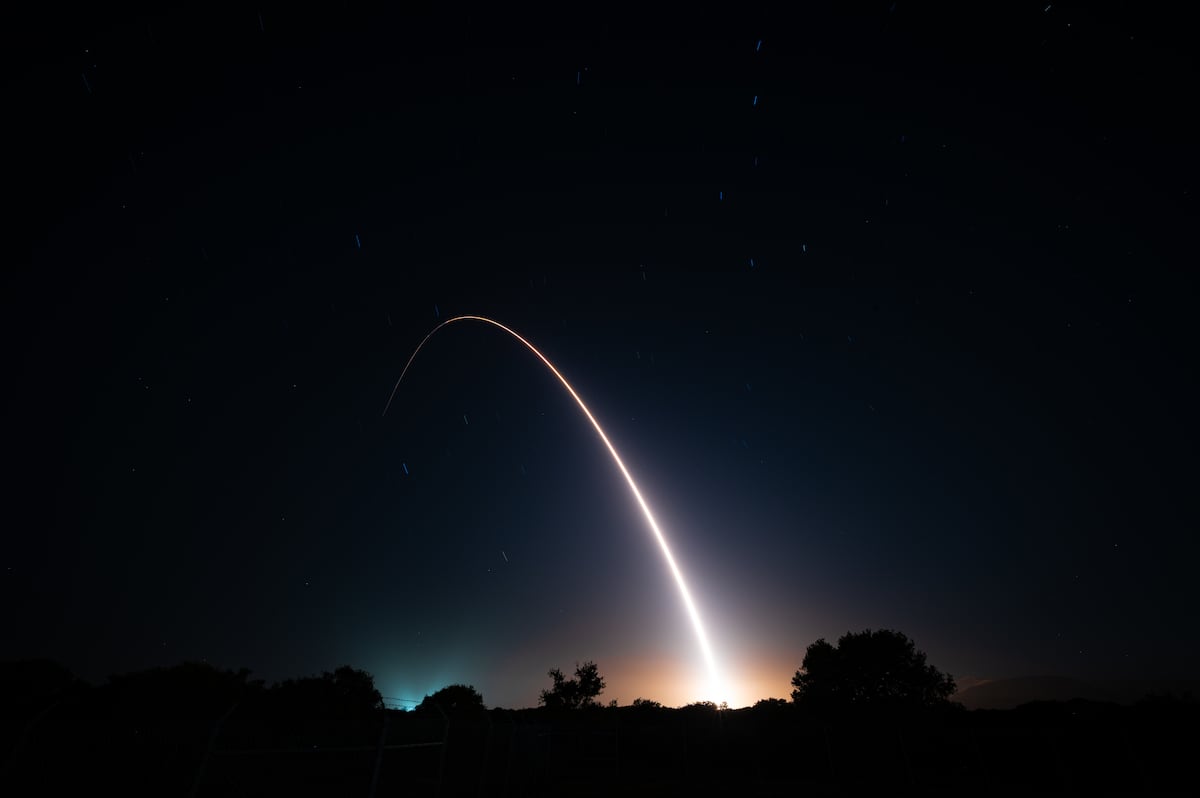Air Force test-launches unarmed Minuteman III missile

The Air Force conducted a midnight test Wednesday of an unarmed Minuteman III intercontinental ballistic missile.
Airmen from Air Force Global Strike Command launched the Minuteman III at 12:01 Pacific time from Vandenberg Space Force Base in California. It flew about 4,200 miles, at a speed of more than 15,000 miles per hour, to a test site at the Kwajalein Atoll in the Marshall Islands.
Sensors at the Ronald Reagan Ballistic Missile Defense Test Site there tracked the missile as it approached and collected radar, optical and telemetry data in its terminal phase, to help measure how well the missile performed. That site is operated by the U.S. Army Space and Missile Defense Command.
“This ICBM test launch underscores the strength of the nation’s nuclear deterrent and the readiness of the ICBM leg of the triad,” Global Strike commander Gen. Thomas Bussiere said in a statement. “This powerful safeguard is maintained by dedicated airmen – missileers, defenders, helicopter operators and the teams who support them – who ensure the security of the nation and its allies.”
The missile was randomly selected and came from Malmstrom Air Force Base in Montana, the Air Force said. It was equipped with a Mark 21 High Fidelity Reentry Vehicle, which would typically contain a nuclear payload if a Minuteman III were launched operationally. The service released video of the test a few hours later.
The 377th Test and Evaluation Group at Vandenberg oversaw the launch, which took place at the base’s Western Test Range. The task force supporting the launch was made up of airmen from all three of the service’s missile wings – the 90th at F.E. Warren Air Force Base in Wyoming, the 91st at Minot Air Force Base in North Dakota, and the 341st at Malmstrom. Maintainers from the 90th and 341st also conducted maintenance for the launch.
The Air Force regularly conducts nighttime tests of the Minuteman III, which is more than 50 years old and nearing the end of its life span, to ensure it continues to function safely and as designed. The service has conducted more than 300 such tests, most recently in February.
The Air Force’s roughly 400 Minuteman III make up the land-based portion of the United States’ nuclear triad, along with submarine-launched nuclear missiles and bombers capable of delivering air-launched weapons.
Minuteman III is expected to be replaced by a new ICBM, the Northrop Grumman-made LGM-35A Sentinel, sometime in the 2030s.
But Sentinel faces multiple challenges. Building its ground-based infrastructure for command and control, including laying thousands of miles of fiberoptic cable across the Great Plains region to connect launch centers, is now expected to be much more complicated than originally anticipated.
The projected future costs of Sentinel grew dramatically enough to trigger a review process known as a critical Nunn-McCurdy breach. The Pentagon concluded that Sentinel remains vital to national security and must continue, and ordered the Air Force to restructure it to bring its costs under control.
Sentinel was originally expected to cost $77.7 billion, but prior to the review was on track to more than double that and cost about $160 billion. However, the Pentagon said last year that a “reasonably modified” version of Sentinel would still cost 81% more than the original estimates, or $140.9 billion.
The Air Force has also concluded it will need to dig entirely new silos for Sentinel, which will further complicate the program. The program originally planned to refurbish the existing network of 55-year-old Minuteman III silos for use by the next generation of ICBMs. But tests showed doing so would create additional problems and cause the program to slip further behind and over budget.
The Air Force plans to primarily dig new silos on existing missile sites, which are already owned by the service.
Stephen Losey is the air warfare reporter for Defense News. He previously covered leadership and personnel issues at Air Force Times, and the Pentagon, special operations and air warfare at Military.com. He has traveled to the Middle East to cover U.S. Air Force operations.







